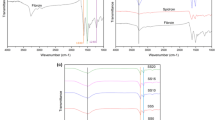Abstract
Silk fibroin–chitosan blend is reported to be an attractive scaffold material for tissue engineering applications. In our earlier study, we developed a scaffold having an optimal silk fibroin–chitosan blend ratio of 80:20 and proved its potentiality for cartilage tissue engineering applications. Glucosamine is one of the major structural components of cartilage tissue. The present work investigates the effect of glucosamine components on the physicochemical and biocompatibility properties of this scaffold. To this end, varied amounts of glucosamine were added to silk fibroin–chitosan blend with the aim of improving various scaffold properties. The addition of glucosamine components did not show any significant change in physicochemical properties of silk fibroin–chitosan blend scaffolds. The composite scaffold showed an open pore structure with desired pore size and porosity. However, cell culture study using human mesenchymal stem cells derived from umbilical cord blood revealed an overall increase in cell supportive properties of glucosamine-added scaffolds. Cell viability, cell proliferation and glycosaminoglycan assays confirmed enhanced cell viability and proliferation of mesenchymal stem cells. Thus, this study demonstrated the beneficial effect of glucosamine on improving the cell supportive property of silk fibroin–chitosan blend scaffolds making it more potential for cartilage tissue regeneration. To the best of our knowledge, this is the first report on the study of glucosamine-added silk fibroin–chitosan blend porous scaffolds seeded with mesenchymal stem cells derived from umbilical cord blood.








Similar content being viewed by others
References
Zheng L, Lu HQ, Fan HS, Zhang XD (2013) Reinforcement and chemical cross-linking in collagen-based scaffolds in cartilage tissue engineering: a comparative study. Iran Polym J 22:833–842
Iwasa J, Engebretsen L, Shima Y, Ochi M (2009) Clinical application of scaffolds for cartilage tissue engineering. Knee Surg Sports Traumatol Arthrosc 17:561–577
Stock UA, Vacanti JP (2001) Tissue engineering: current state and prospects. Annu Rev Med 52:443–451
Vacanti JP, Langer R (1999) Tissue engineering: the design and fabrication of living replacement devices for surgical reconstruction and transplantation. Lancet 354:32–34
Sundelacruz S, Kaplan DL (2009) Stem cell-and scaffold-based tissue engineering approaches to osteochondral regenerative medicine. Semin Cell Dev Biol 20:646–655
Liu H, Ding J, Wang C, Wang J, Wang Y, Yang M, Chen X (2015) Intra-articular transplantation of allogeneic BMMSCs rehabilitates cartilage injury of antigen-induced arthritis. Tissue Eng A 21:2733–2743
Liu H, Ding J, Wang J, Wang Y, Yang M, Zhang Y, Chen X (2015) Remission of collagen-induced arthritis through combination therapy of microfracture and transplantation of thermogel-encapsulated bone marrow mesenchymal stem cells. PLoS ONE 10(3):e0120596
Kuo YC, Lin CY (2006) Effect of genipin crosslinked chitin chitosan scaffolds with hydroxyapatite modifications on the cultivation of bovine knee chondrocytes. Biotechnol Bioeng 95:132–144
Li X, Ding J, Wang J, Zhuang X, Chen X (2015) Biomimetic biphasic scaffolds for osteochondral defect repair. Regen Biomater 2:221–228
Zhang ZZ, Jiang D, Wang SJ, Qi YS, Ding JX, Yu JK, Chen XS (2015) Scaffolds drive meniscus tissue engineering. RSC Adv 5:77851–77859
She ZD, Liu WQ, Feng QL (2009) Preparation and cytocompatibility of silk fibroin/chitosan scaffolds. Front Mater Sci China 3:241–247
He J, Cheng Y, Li P, Zhang Y, Zhang H, Cui S (2013) Preparation and characterization of biomimetic tussah silk fibroin/chitosan composite nanofibers. Iran Polym J 22:537–547
Vishwanath V, Pramanik K, Biswas A (2016) Optimization and evaluation of silk fibroin-chitosan freeze dried porous scaffolds for cartilage tissue engineering application. J Biomater Sci Polym Ed 27:657–674
Li X, Ding J, Zhang Z, Yang M, Yu J, Wang J, Chen X (2016) Kartogenin-incorporated thermogel supports stem cells for significant cartilage regeneration. ACS Appl Mater Interfaces 8:5148–5159
Varghese S, Theprungsirikul P, Sahani S, Hwang N, Yarema KJ, Elisseeff JH (2007) Glucosamine modulates chondrocyte proliferation, matrix synthesis, and gene expression. Osteoarthritis Cartilage 15:59–68
Nakamura H (2011) Application of glucosamine on human disease—osteoarthritis. Carbohydr Polym 84:835–839
Nazarov R, Jin HJ, Kaplan DL (2004) Porous 3-D scaffolds from regenerated silk fibroin. Biomacromolecules 5:718–726
Bhardwaj N, Kundu SC (2011) Silk fibroin protein and chitosan polyelectrolyte complex porous scaffolds for tissue engineering applications. Carbohydr Polym 85:325–333
Pati F, Kalita H, Adhikari B, Dhara S (2013) Osteoblastic cellular responses on ionically crosslinked chitosan-tripolyphosphate fibrous 3D mesh scaffolds. J Biomed Mater Res A 101:2526–2537
Thein-Han WW, Misra RDK (2009) Biomimetic chitosan–nanohydroxyapatite composite scaffolds for bone tissue engineering. Acta Biomater 5:1182–1197
Altman AM, Yan Y, Matthias N, Bai X, Rios C, Mathur AB, Alt EU (2009) IFATS collection: human adipose-derived stem cells seeded on a silk fibroin–chitosan scaffold enhance wound repair in a murine soft tissue injury model. Stem Cells 27:250–258
Anisha BS, Sankar D, Mohandas A, Chennazhi KP, Nair SV, Jayakumar R (2013) Chitosan–hyaluronan/nano chondroitin sulfate ternary composite sponges for medical use. Carbohydr Polym 92:1470–1476
Agarwal T, Narayana SGH, Pal K, Pramanik K, Giri S, Banerjee I (2015) Calcium alginate-carboxymethyl cellulose beads for colon-targeted drug delivery. Int J Biol Macromol 75:409–417
Moreau JL, Xu HH (2009) Mesenchymal stem cell proliferation and differentiation on an injectable calcium phosphate–chitosan composite scaffold. Biomaterials 30:2675–2682
Park H, Temenoff JS, Holland TA, Tabata Y, Mikos AG (2005) Delivery of TGF-β1 and chondrocytes via injectable, biodegradable hydrogels for cartilage tissue engineering applications. Biomaterials 26:7095–7103
Mojarrad JS, Nemati M, Valizadeh H, Ansarin M, Bourbour S (2007) Preparation of glucosamine from exoskeleton of shrimp and predicting production yield by response surface methodology. J Agr Food Chem 55:2246–2250
Acknowledgements
The authors thanks the Department of Biotechnology, Government of India, New Delhi for providing financial support under program support on tissue engineering research and fellowship to one of the authors (BT/01/COE/09/13DT). The authors are also thankful to MHRD, Government of India, New Delhi for providing research facility by sanctioning Center of Excellence (F.No.5-6/2013-TS VII) in tissue engineering and center of excellence in orthopaedic tissue engineering and rehabilitation.
Author information
Authors and Affiliations
Corresponding author
Rights and permissions
About this article
Cite this article
Vishwanath, V., Pramanik, K. & Biswas, A. Development of a novel glucosamine/silk fibroin–chitosan blend porous scaffold for cartilage tissue engineering applications. Iran Polym J 26, 11–19 (2017). https://doi.org/10.1007/s13726-016-0492-y
Received:
Accepted:
Published:
Issue Date:
DOI: https://doi.org/10.1007/s13726-016-0492-y




